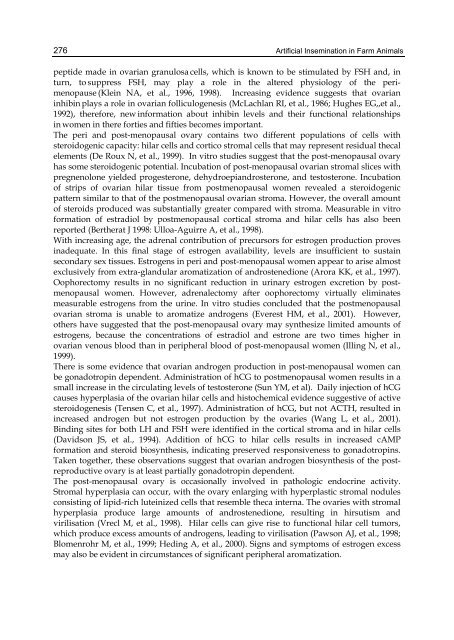ARTIFICIAL INSEMINATION IN FARM ANIMALS - Phenix-Vet
ARTIFICIAL INSEMINATION IN FARM ANIMALS - Phenix-Vet
ARTIFICIAL INSEMINATION IN FARM ANIMALS - Phenix-Vet
You also want an ePaper? Increase the reach of your titles
YUMPU automatically turns print PDFs into web optimized ePapers that Google loves.
276Artificial Insemination in Farm Animalspeptide made in ovarian granulosa cells, which is known to be stimulated by FSH and, inturn, to suppress FSH, may play a role in the altered physiology of the perimenopause(Klein NA, et al., 1996, 1998). Increasing evidence suggests that ovarianinhibin plays a role in ovarian folliculogenesis (McLachlan RI, et al., 1986; Hughes EG,,et al.,1992), therefore, new information about inhibin levels and their functional relationshipsin women in there forties and fifties becomes important.The peri and post-menopausal ovary contains two different populations of cells withsteroidogenic capacity: hilar cells and cortico stromal cells that may represent residual thecalelements (De Roux N, et al., 1999). In vitro studies suggest that the post-menopausal ovaryhas some steroidogenic potential. Incubation of post-menopausal ovarian stromal slices withpregnenolone yielded progesterone, dehydroepiandrosterone, and testosterone. Incubationof strips of ovarian hilar tissue from postmenopausal women revealed a steroidogenicpattern similar to that of the postmenopausal ovarian stroma. However, the overall amountof steroids produced was substantially greater compared with stroma. Measurable in vitroformation of estradiol by postmenopausal cortical stroma and hilar cells has also beenreported (Bertherat J 1998: Ulloa-Aguirre A, et al., 1998).With increasing age, the adrenal contribution of precursors for estrogen production provesinadequate. In this final stage of estrogen availability, levels are insufficient to sustainsecondary sex tissues. Estrogens in peri and post-menopausal women appear to arise almostexclusively from extra-glandular aromatization of androstenedione (Arora KK, et al., 1997).Oophorectomy results in no significant reduction in urinary estrogen excretion by postmenopausalwomen. However, adrenalectomy after oophorectomy virtually eliminatesmeasurable estrogens from the urine. In vitro studies concluded that the postmenopausalovarian stroma is unable to aromatize androgens (Everest HM, et al., 2001). However,others have suggested that the post-menopausal ovary may synthesize limited amounts ofestrogens, because the concentrations of estradiol and estrone are two times higher inovarian venous blood than in peripheral blood of post-menopausal women (Illing N, et al.,1999).There is some evidence that ovarian androgen production in post-menopausal women canbe gonadotropin dependent. Administration of hCG to postmenopausal women results in asmall increase in the circulating levels of testosterone (Sun YM, et al). Daily injection of hCGcauses hyperplasia of the ovarian hilar cells and histochemical evidence suggestive of activesteroidogenesis (Tensen C, et al., 1997). Administration of hCG, but not ACTH, resulted inincreased androgen but not estrogen production by the ovaries (Wang L, et al., 2001).Binding sites for both LH and FSH were identified in the cortical stroma and in hilar cells(Davidson JS, et al., 1994). Addition of hCG to hilar cells results in increased cAMPformation and steroid biosynthesis, indicating preserved responsiveness to gonadotropins.Taken together, these observations suggest that ovarian androgen biosynthesis of the postreproductiveovary is at least partially gonadotropin dependent.The post-menopausal ovary is occasionally involved in pathologic endocrine activity.Stromal hyperplasia can occur, with the ovary enlarging with hyperplastic stromal nodulesconsisting of lipid-rich luteinized cells that resemble theca interna. The ovaries with stromalhyperplasia produce large amounts of androstenedione, resulting in hirsutism andvirilisation (Vrecl M, et al., 1998). Hilar cells can give rise to functional hilar cell tumors,which produce excess amounts of androgens, leading to virilisation (Pawson AJ, et al., 1998;Blomenrohr M, et al., 1999; Heding A, et al., 2000). Signs and symptoms of estrogen excessmay also be evident in circumstances of significant peripheral aromatization.










